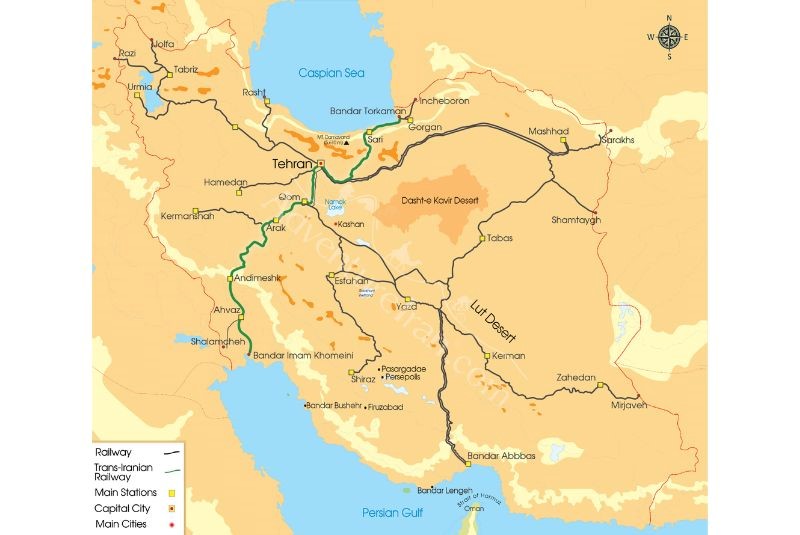Since the major part of Iran’s trade with Russia takes place with the western, more densely populated part of this country, including the cities of Moscow, Saint Petersburg, Kazan, Rostov and the North Caucasus, the main route of trade and transit between the two countries necessarily passes through the Republic of Azerbaijan. Given these circumstances, the lack of a direct rail route has had a very negative impact on the volume and pace of trade along the main transit route between Iran, Azerbaijan and Russia, especially at the “Astara-Astara border crossing”. From here, via the 287-kilometer Astara-Baku national highway, trucks and containers are transported to Azerbaijan and Russia. This causes heavy traffic and in some cases disruptions and long stops at the Astara (Iran)-Astara (Azerbaijan) border crossing, as well as the Samur border crossing at the border between Azerbaijan and Russia, that reduces the volume and speed of the transfer of goods via the corridor. Iran’s Railroad Network is depicted in the map below.
Iran’s Railroad Network.
To overcome this challenge, the construction of two important railway lines was placed on the agenda of the Iranian government. First, the 37-km (22-mile) railway of the Rasht-Caspian project that can connect the city of Rasht, the capital of Gilan province, to the Caspian port and also Bandar Anzali on the Caspian Sea. This railway project was launched in 2006, but between that year and 2019, only three percent progress was made. In recent years, however, its construction has accelerated. Despite the shortness of the 37-km route, the geographical conditions of Gilan province necessitated that 18 large bridges, 243 small bridges and 18 intersections be built along the route of the Rasht-Caspian railway. Eventually, the Rasht-Caspian project was launched at a ceremony attended by Iran’s acting president, Mohammad Mokhber, and Minister of Transport and Urban Development Mehrdad Bazrpash on June 20, 2024. An aide to the Russian president, Igor Levitin, and Astrakhan Oblast Governor Igor Babushkin attended the ceremony on the Russian side. Azerbaijani Deputy Prime Minster Shahin Mustafayev was also there, as well as the ambassadors of the neighbouring countries. The railway of the Rasht-Caspian project is depicted on the map below.
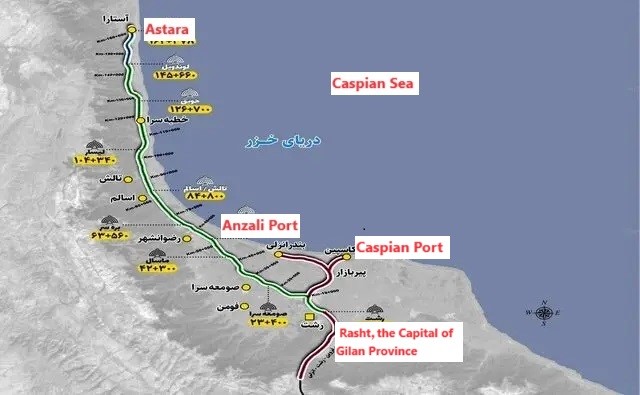
The 37-Kilometer (22-mile) Railway of the Rasht-Caspian Project.
The speed of passenger trains, according to this plan, is 120 km/h and the speed of freight trains is 80 km/h. It is expected that three million tonnes of cargo and 300 thousand passengers will be moved in the first year of operation, and it is also expected that eventually the amount of cargo that will be moved along this line will reach seven million tonnes and the number of passengers will reach 600,000 people.
The primary purpose of the Rasht-Caspian Railway is to enhance connectivity and facilitate transportation and trade links in Iran, the Caspian Sea littoral states, as well as with the railway network southward. Indeed, it is an important part of the International North-South Transport Corridor (INSTC) that connects the Persian Gulf to the Caspian Sea by rail, which can play a very important role in Combined Transport (CT) by sea, land and rail. There is no doubt that the Rasht-Caspian Railway will facilitate the transit process with Baku port in Azerbaijan, as well as Makhachkala, Olya, Astrakhan, Solyanka and Lagan — the main Russian ports on the Caspian Sea. The containers can be immediately transferred from the ship to the train and transported to Bandar Abbas in the Persian Gulf in the south of Iran through the nationwide railway network of Iran. From there, containers can be transported to the ports of India and the Arab countries of the southern part of the Persian Gulf.
But the second important railway project was the Qazvin-Rasht-Astara railway route. Construction of the Rasht-Qazvin railway started in 2009 and as part of this railway route, the Rasht-Qazvin railway was inaugurated on March 6, 2019 by the former president of Iran, Hassan Rouhani. This railway route led to the connection of Rast — the capital of Gilan province, to the national railway network of Iran. Nevertheless, the 164-km Rasht-Astara rail route is still under construction. In the latest development, Russian presidential aide and State Council Secretary Igor Levitin visited this rail route on January 18, 2023. According to the agreement between the two countries, with the investment of the Russians, the rail project is supposed to be completed within three years and will connect to the railway of Azerbaijan’s Astara that was built in 1941 as part of the Soviet railway network. Construction of the 164-km Rasht-Astara railway route is of great importance in the INSTC, because it is the only remaining rail part of this corridor and will facilitate the transit process between Iran, Azerbaijan and Russia in the INSTC. The following map clearly shows the route of the Ghazvin-Rasht Railway in Gilan Province of Iran.
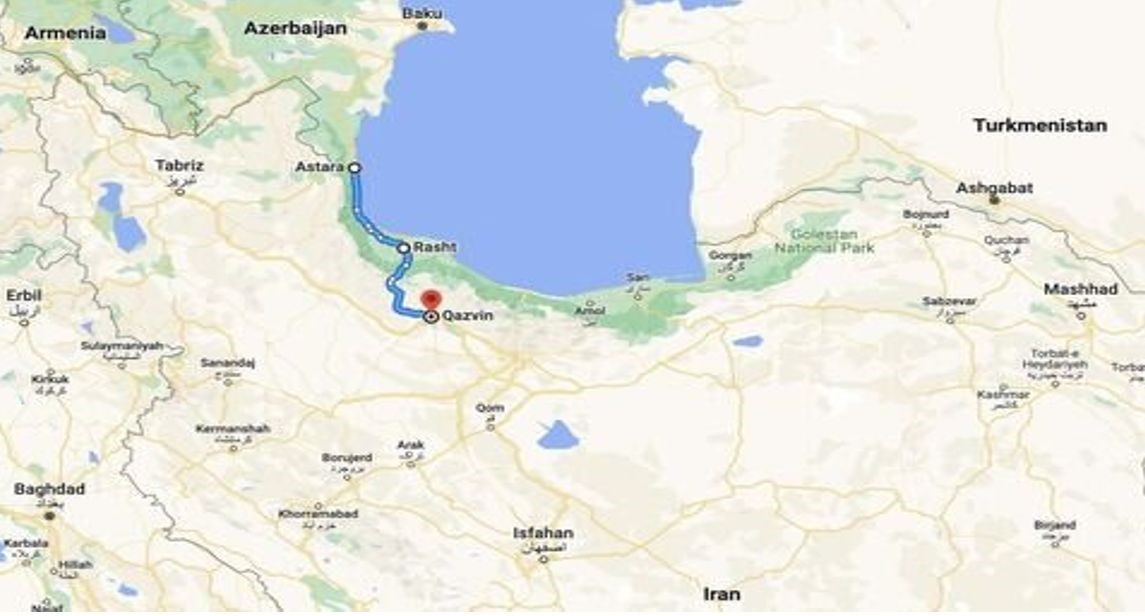
The route of the Ghazvin — Rasht — Astara Railway southwest of the Caspian Sea.
In the south of Iran, efforts are being made to connect the transit ports also to the national rail network of Iran. While ports of Abadan, Khorramshahr and Bandar-e Imam Khomeini in Khuzestan province and Bandar Abbass in Hormozgan province are connected to Iran’s nationwide rail network, the port of Bushehr in Bushehr province and Chabahar port are not yet connected to the rail network. are not yet connected to the national rail network. In order to overcome these challenges, the 645-Kilometer railway from Shiraz, the capital of Fars province in the south of Iran, to the Port of Bushehr is under construction; it is in its final stages and will be put into operation in the near future. With the implementation of this rail route, the Port of Bushehr in the Persian Gulf will be connected to the northern ports of Iran, including Amirabad port in Mazandaran and Anzali and Caspian ports, through a nationwide railway. The following map shows the route of the 645-Kilometer railway from Shiraz-Fars province capital in the south of Iran- to Port of Bushehr in Persian Gulf.
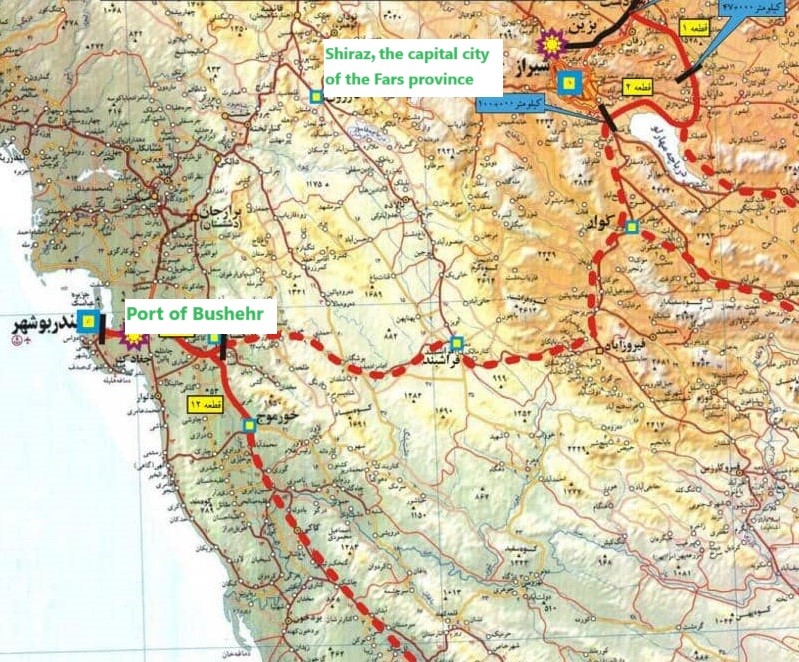
The 645-Kilometer railway from Shiraz —Fars province capital in the south of Iran — to Port of Bushehr in Persian Gulf.
Indeed, the 628-kilometer railway project between the Chabahar port to Zahedan (the capital city of south-eastern Sistan-Baluchestan Province) is under construction. Iran hopes it can be completed in the near future. If the 164-km Rasht-Astara rail route and the 625 km Chabahar-Zahedan rail route are built and completed, it will be possible to transfer cargo and containers from Chabahar port — as the “only ocean port” of Iran — directly to the Republic of Azerbaijan and Russia. Currently, due to the non-completion of the Chabahar-Zahedan railway route, there is a possibility of exporting and importing from Bandar Abbas, which is connected to Iran’s railway network. The Location map of the Chabahar port is depicted on the map below.
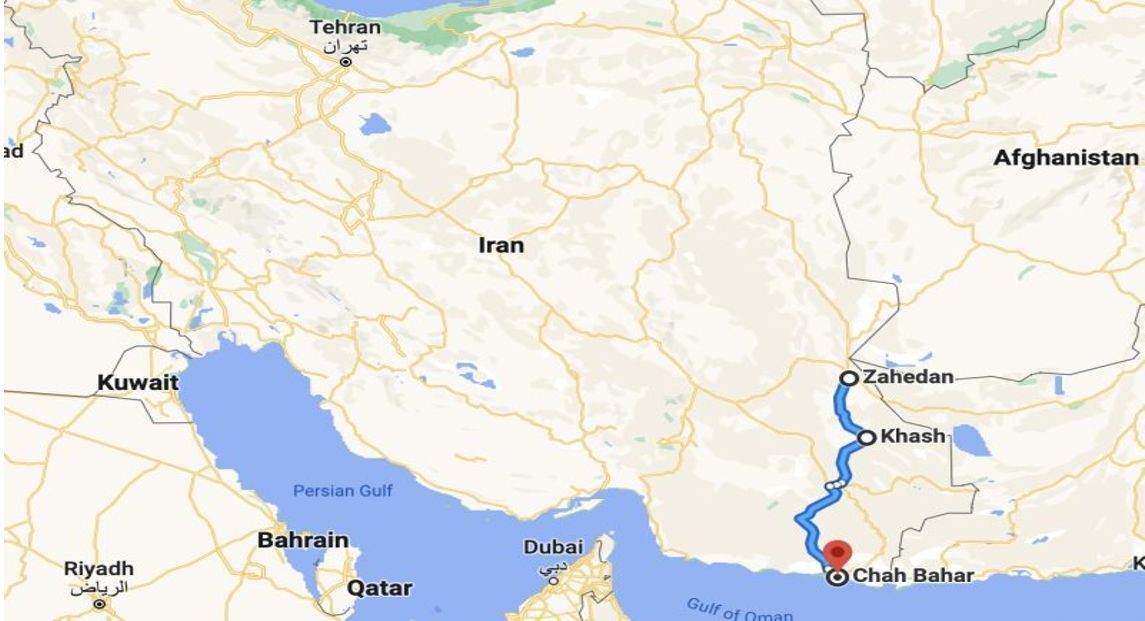
The 628-kilometer railway project between Chabahar port and Zahedan (the capital city of Sistan-Baluchestan province in the south-east).
Following the opening of the 37-km railway of the Rasht-Caspian project, if Iran can build the 164 km Rasht-Astara railway route on the southern part of the Caspian Sea, as well as 645-km railway from Shiraz to the Port of Bushehr in the Persian Gulf and the 625-km rail route from Chabahar port on the Oman Sea to Zahedan, Iran’s long-term and strategic goal of connecting all important ports in the north and south of the country to the national rail network will be realized. In these circumstances, the cycle of “multimodal transportation” and “Combined Transport” (CT) in the North-South Corridor by land, sea and rail routes will also be completed in Iran, which can play a very important role in accelerating and increasing the volume of transit between India and the Arab countries of the southern part of the Persian Gulf with Iran, the countries of Central Asia and the Caucasus, as well as the Russian Federation. Furthermore, completing the process of connecting Iran’s rail network to northern ports along the Caspian Sea and southern ports on the Persian Gulf and Oman Sea can strengthen trade and transit relations between Iran and the Eurasian Economic Union (EEAU) and will have a positive effect on the development of trade between the members and partners of the Shanghai Cooperation Organization (SCO) and BRICS.
The Valdai Discussion Club was established in 2004. It is named after Lake Valdai, which is located close to Veliky Novgorod, where the Club’s first meeting took place.
Please visit the firm link to site


